
Menu:
Behrooz Parhami's Textook on Computer Arithmetic (2e)
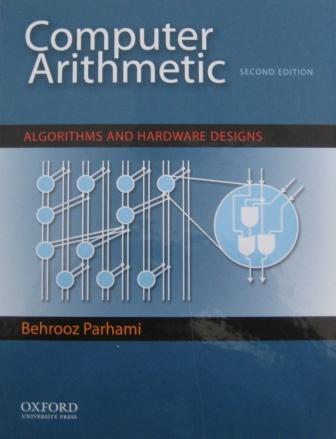
Page last updated on 2020 May 01
B. Parhami, Computer Arithmetic: Algorithms and Hardware Designs, 2nd edition, Oxford University Press, New York, 2010.
(ISBN 978-0-19-532848-6, 641+xxv pp., 316 figures, 718 problems)
Available for purchase from Oxford University Press and various college or on-line bookstores. Instructor's solutions manual is provided gratis by Oxford Univ. Press to instructors who adopt the textbook. For lecture slides and other teaching aids, see below.
Presentations, Lecture Slides (in PowerPoint & PDF formats)
Dedication (to Salem Parhami and others)
Preface to the Second Edition (and Contents-at-a-Glance)
Preface to the First Edition (with list of general references)
Book Reviews for Both Editions
Complete Table of Contents
Instructor's Solutions Manual (Preface, and how to order)
List of Errors in the Second Edition
Additions and Internet Resources
Website for the First Edition (ISBN 0-19-512583-5)
International Second Edition (ISBN 978-0-19-976693-2)
Author's Graduate Course on Computer Arithmetic
Presentations, Lecture Slides
The following PowerPoint and PDF presentation files for the seven parts of the textbook are available for downloading (file sizes up to 2 MB). The date of the last update is provided.
 Part I: Number Representation (ppt, pdf, last updated 2020/03/24)
Part I: Number Representation (ppt, pdf, last updated 2020/03/24)
Part II: Addition / Subtraction (ppt, pdf, last updated 2020/03/28)
Part III: Multiplication (ppt, pdf, last updated 2020/04/15)
Part IV: Division (ppt, pdf, last updated 2020/05/01)
Part V: Real Arithmetic (ppt, pdf, last updated 2015/05/21)
Part VI: Function Evaluation (ppt, pdf, last updated 2015/05/21)
Part VII: Implementation Topics (ppt, pdf, last updated 2010/05/21)
Dedication
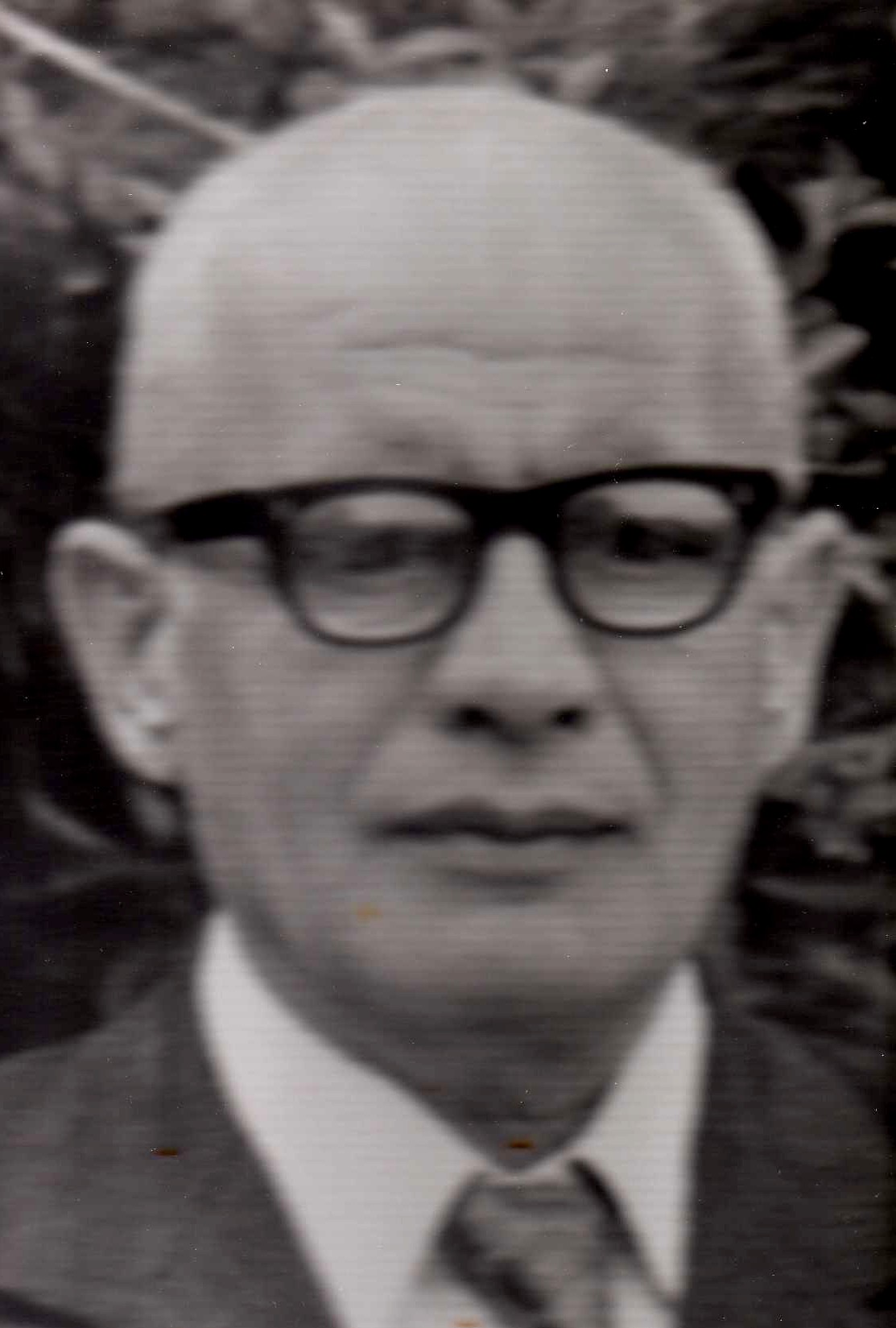 To the memory of my father,
To the memory of my father,
Salem Parhami (1922-1992),
and to all others on whom I can count
for added inspiration,
multiplied joy,
and divided anguish.
Preface to the Second Edition
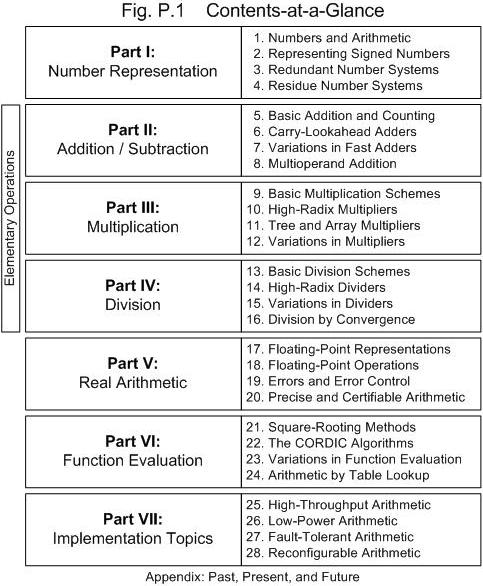
"In a very real sense, the writer writes in order to teach himself, to understand himself, to satisfy himself; the publishing of his ideas, though it brings gratifications, is a curious anticlimax."
(Alfred Kazin)
A decade has passed since the first edition of Computer Arithmetic: Algorithms and Hardware Designs was published. Despite continued advances in arithmetic algorithms and implementation technologies over the past ten years, the book's top-level design remains sound. So, with the exception of including a new chapter on reconfigurable arithmetic, the part/chapter structure, depicted in Fig. P.1, has been left intact in this second edition. The new chapter replaces the previous Chapter 28, whose original contents now appear in an appendix. The author contemplated adding a second appendix listing websites and other Internet resources for further study. But because Internet resource locations and contents are highly dynamic, it was decided to include such information on the author's companion website for the book, which is accessible via his personal Web site at:
http://www.ece.ucsb.edu/~parhami/
The need for a new chapter on reconfigurable arithmetic arises from the fact that, increasingly, arithmetic functions are being implemented on field-programmable gate arrays (FPGAs) and FPGA-like configurable logic devices. This approach is attractive for prototyping new designs, for producing one-of-a-kind or low-volume systems, and for use in rapidly evolving products that need to be upgradeable in the field. It is useful to describe designs and design strategies that have been found appropriate in such a context. The new material blends in nicely with the other three chapters in Part VII, all dealing with implementation topics. Examples covered in the new Chapter 28 include table-based function evaluation, along with several designs for adders and multipliers.
Augmentations, improvements, clarifications, and corrections appear throughout this second edition. Material has been added to many subsections to reflect new ideas and developments. In a number of cases, old subsections have been merged and new subsections created for additional ideas or designs. New and expanded topics that are given section-length treatments in this second edition include the following (section numbers appear in parentheses):
- Modular two-operand and multioperand adders (7.6, 8.6)
- Truncated tree and array multipliers (11.4)
- Overlapped quotient digit selection (15.2)
- Montgomery modular multiplication/reduction (15.4)
- Reciprocation as a special case of division (15.5)
- Floating-point fused-multiply-add units (18.5)
- Interval arithmetic, including interval Newton method (20.6)
- Bipartite and multipartite table methods (24.6)
New end-of-chapter problems have been introduced, bringing the total number of problems to 718 (compared with 464 in the first edition). Rather than include new general reference sources in this preface, the author has taken the liberty of updating and expanding the list of references at the end of the Preface to the First Edition, so as to provide a single comprehensive list.
As always, the author welcomes correspondence on discovered errors, subjects that need further clarification, problem solutions, and ideas for new topics or exercises.
Behrooz Parhami (August 2009, Santa Barbara, CA)
Preface to the First Edition
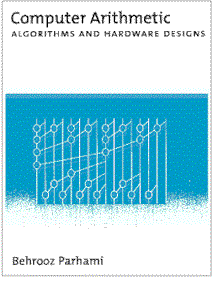
Note: Fig. P.1, referenced in this preface, is the same as the one reproduced above in the Preface to the Second Edition, the only exception being that the new appendix constituted the original Chapter 28 (in lieu of "Reconfigurable Arithmetic").
The context of computer arithmetic
Advances in computer architecture over the past two decades have allowed the performance of digital computer hardware to continue its exponential growth, despite increasing technological difficulty in speed improvement at the circuit level. This phenomenal rate of growth, which is expected to continue in the near future, would not have been possible without theoretical insights, experimental research, and toolbuilding efforts that have helped transform computer architecture from an art into one of the most quantitative branches of computer science and engineering. Better understanding of the various forms of concurrency and the development of a reasonably efficient and user-friendly programming model have been key enablers of this success story.
The downside of exponentially rising processor performance is an unprecedented increase in hardware and software complexity. The trend toward greater complexity is not only at odds with testability and certifiability but also hampers adaptability, performance tuning, and evaluation of the various trade-offs, all of which contribute to soaring development costs. A key challenge facing current and future computer designers is to reverse this trend by removing layer after layer of complexity, opting instead for clean, robust, and easily certifiable designs, while continuing to try to devise novel methods for gaining performance and ease-of-use benefits from simpler circuits that can be readily adapted to application requirements.
In the computer designers' quest for user-friendliness, compactness, simplicity, high performance, low cost, and low power, computer arithmetic plays a key role. It is one of oldest subfields of computer architecture. The bulk of hardware in early digital computers resided in accumulator and other arithmetic/logic circuits. Thus, first-generation computer designers were motivated to simplify and share hardware to the extent possible and to carry out detailed cost-performance analyses before proposing a design. Many of the ingenious design methods that we use today have their roots in the bulky, power-hungry machines of 30-50 years ago.
In fact computer arithmetic has been so successful that it has, at times, become transparent. Arithmetic circuits are no longer dominant in terms of complexity; registers, memory and memory management, instruction issue logic, and pipeline control have become the dominant consumers of chip area in today's processors. Correctness and high performance of arithmetic circuits are routinely expected, and episodes such as the Intel Pentium division bug of the mid 1990s are indeed rare.
The preceding context is changing for several reasons. First, at very high clock rates, the interfaces between arithmetic circuits and the rest of the processor become critical. Arithmetic units can no longer be designed and verified in isolation. Rather, an integrated design optimization is required, which makes the development even more complex and costly. Second, optimizing arithmetic circuits to meet design goals by taking advantage of the strengths of new technologies, and making them tolerant to the weaknesses, requires a reexamination of existing design paradigms. Finally, incorporation of higher-level arithmetic primitives into hardware makes the design, optimization, and verification efforts highly complex and interrelated.
This is why computer arithmetic is alive and well today. Designers and researchers in this area produce novel structures with amazing regularity. Carry-lookahead adders comprise a case in point. We used to think, in the not so distant past, that we knew all there was to know about carry-lookahead fast adders. Yet, new designs, improvements, and optimizations are still appearing. The IEEE 754 standard floating-point format has removed many of the concerns with compatibility and error control in floating-point computations, thus resulting in new designs and products with mass-market appeal. Given the arithmetic-intensive nature of many novel application areas (such as encryption, error checking, and multimedia), computer arithmetic will continue to thrive for years to come.
The goals and structure of this book
The field of computer arithmetic has matured to the point that a dozen or so texts and reference books have been published. Some of these books that cover computer arithmetic in general (as opposed to special aspects or advanced/unconventional methods) are listed at the end of the preface. Each of these books has its unique strengths and has contributed to the formation and fruition of the field. The current text, Computer Arithmetic: Algorithms and Hardware Designs, is an outgrowth of lecture notes the author developed and refined over many years. Here are the most important features of this text in comparison to the listed books:
Division of material into lecture-size chapters. In my approach to teaching, a lecture is a more or less self-contained module with links to past lectures and pointers to what will transpire in future. Each lecture must have a theme or title and must proceed from motivation, to details, to conclusion. In designing the text, I strived to divide the material into chapters, each of which is suitable for one lecture (1-2 hours). A short lecture can cover the first few subsections, while a longer lecture can deal with variations, peripheral ideas, or more advanced material near the end of the chapter. To make the structure hierarchical, as opposed to flat or linear, lectures are grouped into seven parts, each composed of four lectures and covering one aspect of the field (Fig. P.1).
Emphasis on both the underlying theory and actual hardware designs. The ability to cope with complexity requires both a deep knowledge of the theoretical underpinnings of computer arithmetic and examples of designs that help us understand the theory. Such designs also provide building blocks for synthesis as well as reference points for cost-performance comparisons. This viewpoint is reflected in, for example, the detailed coverage of redundant number representations and associated arithmetic algorithms (Chapter 3) that later lead to a better understanding of various multiplier designs and on-line arithmetic. Another example can be found in Chapter 22, where coordinate rotation digital computer, or CORDIC, algorithms are introduced from the more intuitive geometric viewpoint.
Linking computer arithmetic to other subfields of computing. Computer arithmetic is nourished by, and in turn nourishes, other subfields of computer architecture and technology. Examples of such links abound. The design of carry-lookahead adders became much more systematic once it was realized that the carry computation is a special case of parallel prefix computation that had been extensively studied by researchers in parallel computing. Arithmetic for and by neural networks is an area that is still being explored. The residue number system has provided an invaluable tool for researchers interested in complexity theory and the limits of fast arithmetic, as well as to the designers of fault-tolerant digital systems.
Wide coverage of important topics. The text covers virtually all important algorithmic and hardware design topics in computer arithmetic, thus providing a balanced and complete view of the field. Coverage of unconventional number representation methods (Chapters 3 and 4), arithmetic by table lookup (Chapter 24), which is becoming increasingly important, multiplication and division by constants (Chapters 9 and 13), errors and certifiable arithmetic (Chapters 19 and 20), and the topics in Part VII (Chapters 25–28) do not all appear in other textbooks.
Unified and consistent notation/terminology throughout the text. Every effort is made to use consistent notation and terminology throughout the text. For example, r always stands for the number representation radix and s for the remainder in division or square-rooting. While other authors have done this in the basic parts of their texts, many tend to cover more advanced research topics by simply borrowing the notation and terminology from the reference source. Such an approach has the advantage of making the transition between reading the text and the original reference source easier, but it is utterly confusing to the majority of the students, who rely on the text and do not consult the original references except, perhaps, to write a research paper.
Summary of topics
The seven parts of this book, each composed of four chapters, were written with the following goals.
Part I sets the stage, gives a taste of what is to come, and provides a detailed perspective on the various ways of representing fixed-point numbers. Included are detailed discussions of signed numbers, redundant representations, and residue number systems.
Part II covers addition and subtraction, which form the most basic arithmetic building blocks and are often used in implementing other arithmetic operations. Included in the discussions are addition of a constant (counting), various methods for designing fast adders, and multioperand addition.
Part III deals exclusively with multiplication, beginning with the basic shift/add algorithms and moving on to high-radix, tree, array, bit-serial, modular, and a variety of other multipliers. The special case of squaring is also discussed.
Part IV covers division algorithms and their hardware implementations, beginning with the basic shift/subtract algorithms and moving on to high-radix, prescaled, modular, array, and convergence dividers.
Part V PartVdeals with real number arithmetic, including various methods for representing real numbers, floating-point arithmetic, errors in representation and computation, and methods for high-precision and certifiable arithmetic.
Part VI covers function evaluation, beginning with the important special case of square-rooting and moving on to coordinate rotation digital computer, or CORDIC, algorithms, followed by general convergence and approximation methods, including the use of lookup tables.
Part VII deals with broad design and implementation topics, including pipelining, low-power arithmetic, and fault tolerance. This part concludes by providing historical perspective and examples of arithmetic units in real computers.
Pointers on how to use the book
For classroom use, the topics in each chapter of this text can be covered in a lecture lasting 1-2 hours. In his own teaching, the author has used the chapters primarily for 1.5-hour lectures, twice a week, in a 10-week quarter, omitting or combining some chapters to fit the material into 18-20 lectures. But the modular structure of the text lends itself to other lecture formats, self-study, or review of the field by practitioners. In the latter two cases, readers can view each chapter as a study unit (for one week, say) rather than as a lecture. Ideally, all topics in each chapter should be covered before the reader moves to the next chapter. However, if fewer lecture hours are available, some of the subsections located at the end of chapters can be omitted or introduced only in terms of motivations and key results.
Problems of varying complexities, from straightforward numerical examples or exercises to more demanding studies or miniprojects, are supplied for each chapter. These problems form an integral part of the book: they were not added as afterthoughts to make the book more attractive for use as a text. A total of 464 problems are included (15-18 per chapter). Assuming that two lectures are given per week, either weekly or biweekly homework can be assigned, with each assignment having the specific coverage of the respective half-part (two chapters) or full-part (four chapters) as its "title."
An instructor's solutions manual is available. The author's detailed syllabus for the course ECE 252B at UCSB is available at:
http://www.ece.ucsb.edu/~parhami/ece_252b.htm
A simulator for numerical experimentation with various arithmetic algorithms is available at:
http://www.ecs.umass.edu/ece/koren/arith/simulator
courtesy of Professor Israel Koren.
References to classical papers in computer arithmetic, key design ideas, and important state-of-the-art research contributions are listed at the end of each chapter. These references provide good starting points for in-depth studies or for term papers or projects. A large number of classical papers and important contributions in computer arithmetic have been reprinted in two volumes [Swar90].
New ideas in the field of computer arithmetic appear in papers presented at biannual conferences, known as ARITH-n, held in odd-numbered years [Arit]. Other conferences of interest include Asilomar Conference on Signals, Systems, and Computers [Asil], International Conference on Circuits and Systems [ICCS], Midwest Symposium on Circuits and Systems [MSCS], and International Conference on Computer Design [ICCD]. Relevant journals include IEEE Transactions on Computers [TrCo], particularly its special issues on computer arithmetic, IEEE Transactions on Circuits and Systems [TrCS], Computers & Mathematics with Applications [CoMa], IET Circuits, Devices & Systems [CDS], IET Computers & Digital Techniques [CDT], IEEE Transactions on VLSI Systems [TrVL], and Journal of VLSI Signal Processing [JVSP].
Acknowledgments
Computer Arithmetic: Algorithms and Hardware Designs is an outgrowth of lecture notes the author used for the graduate course "ECE 252B: Computer Arithmetic" at the University of California, Santa Barbara, and, in rudimentary forms, at several other institutions prior to 1988. The text has benefited greatly from keen observations, curiosity, and encouragement of my many students in these courses. A sincere thanks to all of them!
General references
Note: References appear in updated 2nd-edition form, in order to avoid the need for a separate list for the latter.
[Arit] International Symposium on Computer Arithmetic, Sponsored by IEEE Computer Society. This series began with a one-day workshop in 1969 and was subsequently held in 1972, 1975, 1978, and in odd-numbered years since 1981. The 19th symposium in the series, ARITH-19, was held on June 8-10, 2009, in Portland, Oregon.
[Asil] Asilomar Conference on Signals Systems, and Computes, sponsored annually by IEEE and held on the Asilomar Conference Grounds in Pacific Grove, California, each fall. The 43rd conference in this series was held on November 1-4, 2009.
[Cava84] Cavanagh, J. J. F., Digital Computer Arithmetic: Design and Implementation, McGraw-Hill, 1984.
[CDS] IET Circuits, Devices & Systems, journal published by the Institution of Engineering and Technology, United Kingdom.
[CDT] IET Computers & Digital Techniques, journal published by the Institution of Engineering and Technology, United Kingdom.
[CoMa] Computers & Mathematics with Applications, journal published by Pergamon Press.
[Desc06] Deschamps, J.-P., G. J. A. Bioul, and G. D. Sutter, Synthesis of Arithmetic Circuits: FPGA, ASIC and Embedded Systems, Wiley-Interscience, 2006.
[Erce04] Ercegovac, M. D., and T. Lang, Digital Arithmetic, Morgan Kaufmann, 2004.
[Flor63] Flores, I., The Logic of Computer Arithmetic, Prentice-Hall, 1963.
[Gosl80] Gosling, J. B., Design of Arithmetic Units for Digital Computers, Macmillan, 1980.
[Hwan79] Hwang, K., Computer Arithmetic: Principles, Architecture, and Design, Wiley, 1979.
[ICCD] International Conference on Computer Design, sponsored annually by the IEEE Computer Society. ICCD-2009 was held on October 4-7, in Lake Tahoe, California.
[ICCS] International Conference on Circuits and Systems, sponsored annually by the IEEE Circuits and Systems Society. The latest in this series was held on May 24-27, 2009, in Taipei, Taiwan.
[JVSP] J. VLSI Signal Processing, published by Kluwer Academic Publishers.
[Knut81] Knuth, D. E., The Art of Computer Programming, Vol. 2: Seminumerical Algorithms, 3rd ed., Addison-Wesley, 1997. (The widely used second edition, published in 1981, is cited in Parts V and VI.)
[Kore02] Koren, I., Computer Arithmetic Algorithms, 2nd ed., A. K. Peters, 2002.
[Kuli81] Kulisch, U. W. and W. L. Miranker, Computer Arithmetic in Theory and Practice, Academic Press, 1981.
[Lu04] Lu, M., Arithmetic and Logic in Computer Systems, Wiley, 2004.
[MSCS] Midwest Symposium on Circuits and Systems, sponsored annually by the IEEE Circuits and Systems Society.
[Omon94] Omondi, A. R., Computer Arithmetic Systems: Algorithms, Architecture and Implementation, Prentice-Hall, 1994.
[Rich55] Richards, R. K., Arithmetic Operations in Digital Computers, Van Nostrand, 1955.
[Scot85] Scott, N. R., Computer Number Systems and Arithmetic, Prentice-Hall, 1985.
[Stei71] Stein, M. L. and W. D. Munro, Introduction to Machine Arithmetic, Addison-Wesley, 1971.
[Stin04] Stine, J. E., Digital Computer Arithmetic Datapath Design Using Verilog HDL, Kluwer, 2004.
[Swar90] Swartzlander, E. E., Jr., Computer Arithmetic, Vols. I and II, IEEE Computer Society Press, 1990.
[TrCo] IEEE Trans. Computers, journal published by the IEEE Computer Society. Occasionally devotes entire special issues or sections to computer arithmetic (e.g., Vol. 19, No. 8, August 1970; Vol. 22, No. 6, June 1973; Vol. 26, No. 7, July 1977; Vol. 32, No. 4, April 1983; Vol. 39, No. 8, August 1990; Vol. 41, No. 8, August 1992; Vol. 43, No. 8, August 1994; Vol. 47, No. 7, July 1998; Vol. 49, No. 7, July 2000; Vol. 54, No. 3, March 2005; Vol. 58, No. 2, February 2009.
[TrCS] IEEE Trans. Circuits and Systems, Parts I and II, journals published by IEEE. The two parts have been distinguished differently over the years. Currently, Part I publishes "regular papers," while Part II is devoted to "express briefs."
[TrVL] IEEE Trans. Very Large Scale Integration (VLSI) Systems, journal published jointly by the IEEE Circuits and Systems Society, Computer Society, and Solid-State Circuits Council.
[Wase82] Waser, S. and M. J. Flynn, Introduction to Arithmetic for Digital Systems Designers, Holt, Rinehart, & Winston, 1982.
[Wino80] Winograd, S., Arithmetic Complexity of Computations, SIAM, 1980.
Book Reviews
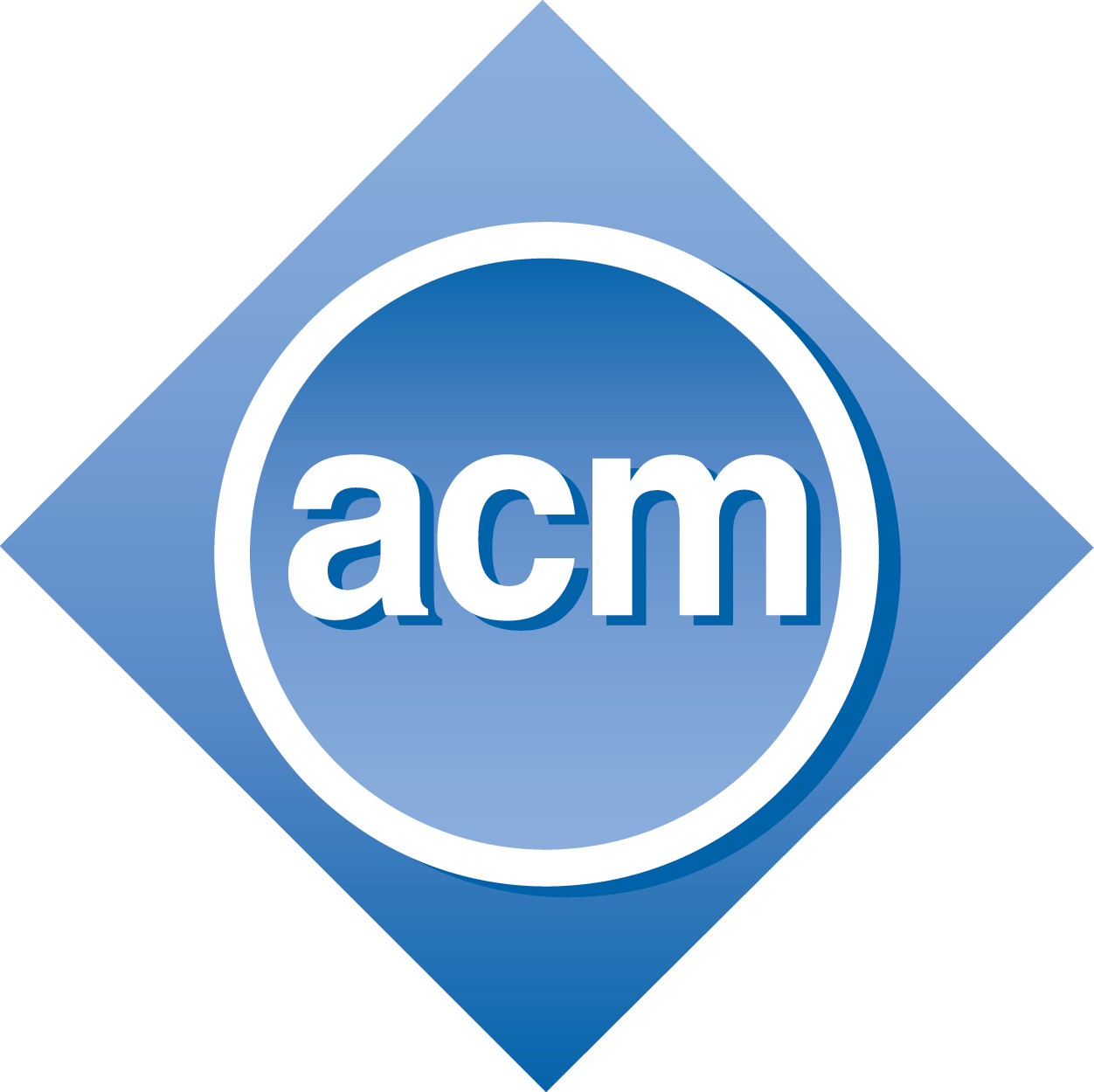
The following review is for the 1st edition of the book Computer Arithmetic: Algorithms and Hardware Designs (B. Parhami, Oxford)
Published in: ACM Computing Reviews, October 1999
Reviewer: Peter Turner
Indexing info: Computer arithmetic (G.1.0), General (B.2.0), Algorithms, Design
This well-organized text for a course in computer arithmetic at the senior undergraduate or beginning graduate level is divided into seven parts, each comprising four chapters. Each part is intended to occupy one or two lectures. The book has clearly benefited from the author's experience in teaching this material. It achieves a nice balance among the mathematical development of algorithms and discussion of their implementation.
Each chapter has 15 or more exercises, of varying difficulty and nature, and its own references. I would have liked to see a comprehensive bibliography for the whole book as well, since this could include items that are not specifically referred to in the text.
The first four parts are devoted to number representation, addition and subtraction, multiplication, and division. These are concerned with integer (or at least fixed-point) arithmetic. The next two parts deal with real arithmetic and function evaluation. The final part, "Implementation Topics," covers some practical engineering aspects.
Part 1 has chapters titled "Numbers and Arithmetic," "Representing Signed Numbers," "Redundant Number Systems," and "Residue Number Systems." The first begins with a brief history of the Intel division bug, which serves to introduce the significance of computer arithmetic. A second "motivating example" is based on high-order roots and powers. The primary content describes fixed-radix number systems and radix conversion. It is typical of the book that these sections contain many well-chosen examples and diagrams.
The chapter on signed numbers covers the expected material: sign-magnitude, biased, and complemented representations, including the use of signed digits. Redundant number systems are introduced within the discussion of carry propagation. The mathematical basis for carry-free addition is discussed along with its algorithm. Residue number systems are discussed, beginning with the representation and the choice of moduli. The explanation of conversion to and from the binary system includes a good description of the Chinese remainder theorem.
Part 2, on addition and subtraction, begins with the basics of half and full adders, and carry-ripple adders. This motivates the chapter on carry-lookahead adders. The basic idea and its implementation are presented well. This chapter finishes with a short section on VLSI implementation, which gives pointers to further study. Similar sections appear in most chapters. Variations on the carry-lookahead theme are the subject of the next chapter, while Wallace and Dadda trees of carry-save adders are the final addition topics. This provides a natural link to multiplication.
The basic structure of parts 3 and 4 (on multiplication and division) is the same. There are chapters on basic and high-radix multiplication and division. Tree and array multipliers, and special variations (for squaring and multiply-accumulate) complete the multiplication part. The final chapter on division covers Newton-like methods. One of my few criticisms of the book is that the explanation of SRT and digit selection could be more extensive. A student unfamiliar with these topics might have difficulty gaining a full understanding of this important technique.
Part 5 is concerned with real arithmetic, and the floating-point system in particular. The chapter on real-number representation includes a brief section on logarithmic arithmetic, which offers the student a glimpse of alternatives. Other schemes such as Hamada's "Universal Representation of Real Numbers" or symmetric level-index could also have been mentioned here. Floating-point arithmetic is described using the integer operations. Rounding and normalization are also discussed. Chapter 19 is a short chapter on errors and their control, which covers most of the basics without giving all the details. For a mathematics course on computer arithmetic, this chapter would need expanding. The final chapter on real arithmetic describes continued fraction, multiple precision, and interval arithmetic.
Part 6 covers function evaluation, with chapters on square-rooting, CORDIC algorithms, variations (iterative methods and approximations), and table lookup. Each chapter describes the basic ideas well and provides a sufficient taste of its subject matter to point the interested student to further study. The description of the CORDIC algorithms is more complicated than necessary. Use of an elementary trigonometric identity would simplify some of the formulas substantially. The use of degrees in the introduction to the CORDIC algorithm is also a dubious choice.
The final part has chapters on high-throughput, low-power, and fault-tolerant arithmetic. Each is fairly brief but would serve as an introduction to some of the practical engineering aspects of computer arithmetic.
Overall, Parhami has done an excellent job of presenting the fundamentals of computer arithmetic in a well-balanced, careful, and organized manner. The care taken by the author is borne out by the almost total absence of typos or incorrect cross-references. I would choose this book as a text for a first course in computer arithmetic.
Complete Table of Contents
Note: Each chapter ends with problems and references.
Part I: Number Representation
1 Numbers and Arithmetic ~
1.1 What is computer arithmetic? ~
1.2 Motivating Examples ~
1.3 Numbers and their encodings ~
1.4 Fixed-radix positional number systems ~
1.5 Number radix conversion ~
1.6 Classes of number representations
2 Representing Signed Numbers ~
2.1 Signed-magnitude representation ~
2.2 Biased representations ~
2.3 Complement representations ~
2.4 Two's- and 1's-complement numbers ~
2.5 Direct and indirect signed arithmetic ~
2.6 Using signed positions or signed digits
3 Redundant Number Systems ~
3.1 Coping with the carry problem ~
3.2 Redundancy in computer arithmetic ~
3.3 Digit sets and digit-set conversions ~
3.4 Generalized signed-digit numbers ~
3.5 Carry-free addition algorithms ~
3.6 Conversions and support functions
4 Residue Number Systems ~
4.1 RNS representation and arithmetic ~
4.2 Choosing the RNS moduli ~
4.3 Encoding and decoding of numbers ~
4.4 Difficult RNS arithmetic operations ~
4.5 Redundant RNS representations ~
4.6 Limits of fast arithmetic in RNS
Part II: Addition/Subtraction
5 Basic Addition and Counting ~
5.1 Bit-serial and ripple-carry adders ~
5.2 Conditions and exceptions ~
5.3 Analysis of carry propagation ~
5.4 Carry completion detection ~
5.5 Addition of a constant: counters ~
5.6 Manchester carry chains and adders
6 Carry-Lookahead Adders ~
6.1 Unrolling the carry recurrence ~
6.2 Carry-lookahead adder design ~
6.3 Ling adder and related designs ~
6.4 Carry determination as prefix computation ~
6.5 Alternative parallel prefix networks
6.6 VLSI implementation aspects
7 Variations in Fast Adders ~
7.1 Simple carry-skip adders ~
7.2 Multilevel carry-skip adders ~
7.3 Carry-select adders ~
7.4 Conditional-sum adder ~
7.5 Hybrid designs and optimizations ~
7.6 Modular two-operand adders
8 Multi-Operand Addition ~
8.1 Using two-operand adders ~
8.2 Carry-save adders ~
8.3 Wallace and Dadda trees ~
8.4 Parallel counters and compressors ~
8.5 Adding multiple signed numbers ~
8.6 Modular multioperand adders
Part III: Multiplication
9 Basic Multiplication Schemes ~
9.1 Shift/add multiplication algorithms ~
9.2 Programmed multiplication ~
9.3 Basic hardware multipliers ~
9.4 Multiplication of signed numbers ~
9.5 Multiplication by constants ~
9.6 Preview of fast multipliers
10 High-Radix Multipliers ~
10.1 Radix-4 multiplication ~
10.2 Modified Booth's recoding ~
10.3 Using carry-save adders ~
10.4 Radix-8 and radix-16 multipliers ~
10.5 Multibeat multipliers ~
10.6 VLSI complexity issues
11 Tree and Array Multipliers ~
11.1 Full-tree multipliers ~
11.2 Alternative reduction trees ~
11.3 Tree multipliers for signed numbers ~
11.4 Partial-tree and truncated multipliers ~
11.5 Array multipliers ~
11.6 Pipelined tree and array multipliers
12 Variations in Multipliers ~
12.1 Divide-and-conquer designs ~
12.2 Additive multiply modules ~
12.3 Bit-serial multipliers ~
12.4 Modular multipliers ~
12.5 The special case of squaring ~
12.6 Combined multiply-add units
Part IV: Division
13 Basic Division Schemes ~
13.1 Shift/subtract division algorithms ~
13.2 Programmed division ~
13.3 Restoring hardware dividers ~
13.4 Nonrestoring and signed division ~
13.5 Division by constants ~
13.6 Radix-2 SRT division
14 High-Radix Dividers ~
14.1 Basics of high-radix division ~
14.2 Using carry-save adders ~
14.3 Radix-4 SRT division ~
14.4 General high-radix dividers ~
14.5 Quotient-digit selection ~
14.6 Using p-d plots in practice
15 Variations in Dividers ~
15.1 Division with prescaling ~
15.2 Overlapped quotient-digit selection ~
15.3 Combinational and array dividers ~
15.4 Modular dividers and reducers ~
15.5 The special case of reciprocation ~
15.6 Combined multiply/divide units
16 Division by Convergence ~
16.1 General convergence methods ~
16.2 Division by repeated multiplications ~
16.3 Division by reciprocation ~
16.4 Speedup of convergence division ~
16.5 Hardware implementation ~
16.6 Analysis of lookup table size
Part V: Real Arithmetic
17 Floating-Point Representations ~
17.1 Floating-point numbers ~
17.2 The ANSI/IEEE floating-point standard ~
17.3 Basic floating-point algorithms ~
17.4 Conversions and exceptions ~
17.5 Rounding schemes ~
17.6 Logarithmic number systems
18 Floating-Point Operations ~
18.1 Floating-point adders/subtractors ~
18.2 Pre- and postshifting ~
18.3 Rounding and exceptions ~
18.4 Floating-point multipliers and dividers ~
18.5 Fused-multiply-add units ~
18.6 Logarithmic arithmetic unit
19 Arithmetic Errors and Error Control ~
19.1 Sources of computational errors ~
19.2 Invalidated laws of algebra ~
19.3 Worst-case error accumulation ~
19.4. Error distribution and expected errors ~
19.5 Forward error analysis ~
19.6 Backward error analysis
20 Precise and Certifiable Arithmetic ~
20.1 High precision and certifiability ~
20.2 Exact arithmetic ~
20.3 Multiprecision arithmetic ~
20.4 Variable-precision arithmetic ~
20.5 Error bounding via interval arithmetic ~
20.6 Adaptive and lazy arithmetic
Part VI: Function Evaluation
21 Square-Rooting Methods ~
21.1 The pencil-and-paper algorithm ~
21.2 Restoring shift/subtract algorithm ~
21.3 Binary non-restoring algorithm ~
21.4 High-radix square-rooting ~
21.5 Square-rooting by convergence ~
21.6 Fast hardware square-rooters
22 The CORDIC Algorithms ~
22.1 Rotations and pseudorotations ~
22.2 Basic CORDIC iterations ~
22.3 CORDIC hardware ~
22.4 Generalized CORDIC ~
22.5 Using the CORDIC method ~
22.6 An algebraic formulation
23 Variations in Function Evaluation ~
23.1 Additive/multiplicative normalization ~
23.2 Computing logarithms ~
23.3 Exponentiation ~
23.4 Division and square-rooting, again ~
23.5 Use of approximating functions ~
23.6 Merged arithmetic
24 Arithmetic by Table Lookup ~
24.1 Direct and indirect table lookup ~
24.2 Binary-to-unary reduction ~
24.3 Tables in bit-serial arithmetic ~
24.4 Interpolating memory ~
24.5 Piecewise lookup tables ~
24.6 Multipartite table methods
Part VII: Implementation Topics
25 High-Throughput Arithmetic ~
25.1 Pipelining of arithmetic functions ~
25.2 Clock rate and throughput ~
25.3 The Earle latch ~
25.4 Parallel and digit-serial pipelines ~
25.5 On-line or digit-pipelined arithmetic ~
25.6 Systolic arithmetic units
26 Low-Power Arithmetic ~
26.1 The need for low-power design ~
26.2 Sources of power consumption ~
26.3 Reduction of power waste ~
26.4 Reduction of activity ~
26.5 Transformations and trade-offs ~
26.6 New and emerging methods
27 Fault-Tolerant Arithmetic ~
27.1 Faults, errors, and error codes ~
27.2 Arithmetic error-detecting codes ~
27.3 Arithmetic error-correcting codes ~
27.4 Self-checking function units ~
27.5 Algorithm-based fault tolerance ~
27.6 Fault-tolerant RNS arithmetic
28 Reconfigurable Arithmetic ~
28.1 Programmable logic devices ~
28.2 Adder designs for FPGAs ~
28.3 Multiplier and divider designs ~
28.4 Tabular and distributed arithmetic ~
28.5 Function evaluation on FPGAs ~
28.6 Beyond fine-grained devices
Appendix: Past, Present, and Future ~ A.1 Historical perspective ~ A.2 Early high-performance machines ~ A.3 Deeply pipelined vector machines ~ A.4 The DSP revolution ~ A.5 Supercomputers on our laps ~ A.6 Trends, outlook, and resources
Instructor's Solutions Manual
Preface to the Instructor's Solutions Manual:
This manual, which is provided gratis by Oxford University Press to insructors who adopt Computer Arithmetic: Algorithms and Hardware Designs (2nd ed), contains solutions to selected end-of-chapter problems. Please refrain from posting any of these solutions to course Web sites, so that the textbook does not lose its value for other instructors.
A variety of other information and teaching resources, as well as an errata for both the textbook and this manual, are available via the author's companion Web site at:
http://www.ece.ucsb.edu/~parhami/text_comp_arit.htm
The author would appreciate the reporting of any error in the textbook or in this manual, suggestions for additional problems, alternate solutions to solved problems, solutions to other problems, and sharing of teaching experiences. Please e-mail your comments to "parhami at ece dot ucsb dot edu" or send them by regular mail to the author's postal address:
Dept. Electrical & Computer Engineering
University of California
Santa Barbara, CA 93106-9560, USA
Contributions will be acknowledged to the extent possible
List of Errors in the Second Edition
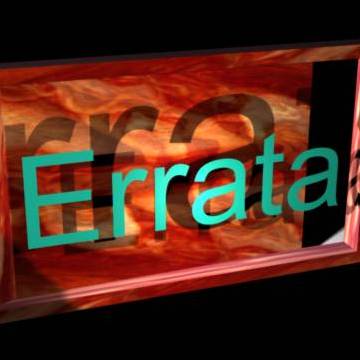
The list that follows is presented in the order of page numbers in the book's second edition. For each list entry, the date of its addition to the list or its last modification is provided in square brackets.
For a list of errors in, and additions to, the first edition, please refer to the
website for B. Parhami's Computer Arithmetic, 1st edition
[2010/08/09] Page xvi, line 9: Replace "(20.6)" by "(20.5)".
[2010/10/24] Page xxiii, line –2: ", Devices & Systems" should be in italics (it is part of the journal's name).
[2015/04/28] Page 5, Fig. 1.1: Replace "Error analysi" under "Hardware Issues" with "Error analysis".
[2010/10/24] Page 22, line 1: Replace "least-significant bits" by "least-significant bit".
[2015/12/10] Page 67, line –1: Replace "modules" by "modulus".
[2013/04/17] Page 123, Fig. 6.11: Replace the lower of the two circles on line x1 with a heavy black dot (i.e., it should be a simple connection, not a computational element).
[2010/04/04] Page 134, line –8: Replace "1 + t – 2" by "t – 1".
[2012/05/03] Page 152, Problem 7.28: At the end of the problem statement, add: "Do not worry that the first configuration yields a 33-bit adder."
[2014/04/18] Page 294, Fig. 14.4: Replace the "sign" label on the lower mux input with "sign_bar" (complement of "sign").
[2015/06/11] Page 304, line –8: Insert space between "p" and "must".
[2010/08/09] Page 321, lines 4 and 5: Replace "M-codes" with "M-codes" (i.e., do not italicize M).
[2015/06/11] Page 392, Problem 18.25, heading: Correct "Logarithmemic" to "Logarithmic".
[2013/06/05] Page 399, Example 19.2, line 4: x and its floating-point representation should be positive.
[2016/08/17] Page 409, Problem 19.9 part c: The + on the last line should change to +_fp (+ with the subscript fp).
[2010/08/09] Page 593, Fig. 28.5: Add a downward arrow to the bottom of the middle adder to represent 6 output lines.
[2010/04/04] Page 629, line 1: Insert missing "B" at the end of "PROVERB".
Additions and Internet Resources
 The entries in this section are identified by, and listed in the order of, book chapters.
The entries in this section are identified by, and listed in the order of, book chapters.
Page numbers are also given where appropriate.
Within each chapter, entries appear in reverse chronological order of the date of introduction into this list or of the last update.
Chapter 20: Precise and Certifiable Arithmetic
2012/07/11: Tutorial on interval arithmetic (Section 20.5)
Here is an excellent tutorial article on interval arithmetic (and its use for automatic error analysis in engineering calculations) that makes reference to the INTLAB extension to MATLAB for interval computation.
[Roth12] Rothwell, E. J. and M. J. Cloud, "Automatic Error Analysis Using Intervals," IEEE Trans. Education, Vol. 55, No. 1, pp. 9-15, February 2012.
Chapter 22: The CORDIC Algorithms
2010/03/19: New CORDIC speedup method
Recoding of the CORDIC rotation angle can reduce the number of iterations by 50%, but each iteration would take longer due to the more complex angle selection process. The method proposed in [Rodr10] mitigates the added complexity by parallel determination of all rotation angles at the outset.
[Rodr10] Rodrigues, T. K. and E. E. Swarzlander Jr., "Adaptive CORDIC: Using Parallel Angle Recoding to Accelerate Rotations," IEEE Trans. Computers, Vol. 59, No. 4, pp. 522-531, April 2010.
2009/09/09: New historical/review article about CORDIC
[Mehe09] Meher, P. K., J. Valls, T.-B. Juang, K. Sridharan, and K. Maharatna, "50 Years of CORDIC: Algorithms, Architectures, and Applications," IEEE Trans. Circuits and Systems I, Vol. 56, No. 9, pp. 1893-1907, September 2009.
Chapter 28: Reconfigurable Arithmetic
2010/03/30: Carry-save arithmetic on FPGAs
A more up to date version of reference [Bris07] on p. 607 is as follows:
[Para10] Parandeh-Afshar, H., A. K. Verma, P. Brisk, and P. Ienne, "Improving FPGA Performance for Carry-Save Arithmetic," IEEE Trans. VLSI Systems, Vol. 18, No. 4, pp. 578-590, April 2010.
Appendix A: Past, Present, and Future
2012/07/11: Mixed analog/digital arithmetic
Analog computation can have speed and energy-economy advantages over its digital counterpart, but it is by and large limited to low-precision applications. Thus, modern computer systems rely almost exclusively on digital number representation and manipulation. It turns out that mixed analog/digital approaches may have benefits in terms of speed and robustness (noise immunity) with certain implementation technologies, while also offering acceptable precision. The continuous-valued digits of Saed et al. [Saed02], extended and refined by Mirhassani et al. [Mirh08], provide one possible approach that can be likened to the way in which an electric energy meter uses a sequence of analog dials (the first dial provides an approximate representation of the total energy and subsequent dials supply greater detail and precision). In another domain, and with different motivation, Parhami has investigated residue number systems with continuous residues, which are thought to enable the navigational and location-awareness system of rats [Parh09].
[Saed02] Saed, A., M. Ahmadi, and G. A. Jullien, "A Number System with Continuous Valued Digits and Modulo Arithmetic," IEEE Trans. Computers, Vol. 51, No. 11, pp. 1294-1305, Nov. 2002.
[Mirh08] Mirhassani, M., M. Ahmadi, and G. A. Jullien, "Low-Power Mixed-Signal CVNS-Based 64-Bit Adder for Media Signal Processing," IEEE Trans. VLSI Systems, Vol. 16, No. 9, pp. 1141-1151, September 2008.
[Parh09] Parhami, B., "Digital/Analog Arithmetic with Continuous-Valued Residues," Proc. 43rd Asilomar Conf. Signals, Systems, and Computers, November 2009, pp. 1787-1791.
International Second Edition of the Book
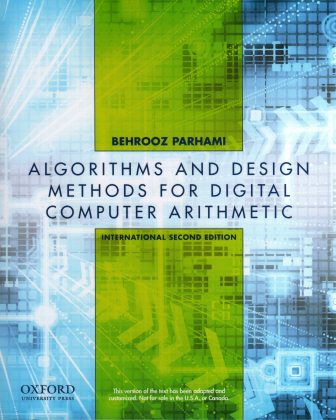 Parhami, B., Algorithms and Design Methods for Digital Computer Arithmetic, Oxford University Press, New York, 2012.
Parhami, B., Algorithms and Design Methods for Digital Computer Arithmetic, Oxford University Press, New York, 2012.
(ISBN 978-0-19-976693-2, 623+xxi pp., 316 figures, 668 problems)
(ISBN for the instructor's solutions manual 978-0-19-976694-9, 197 pp.)